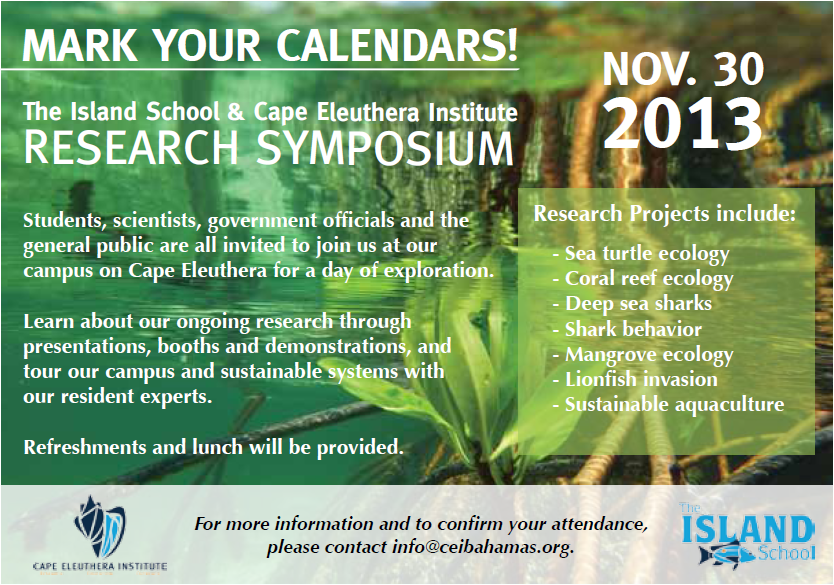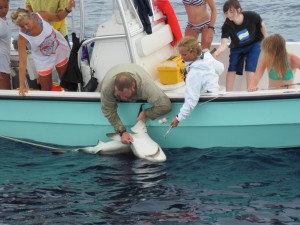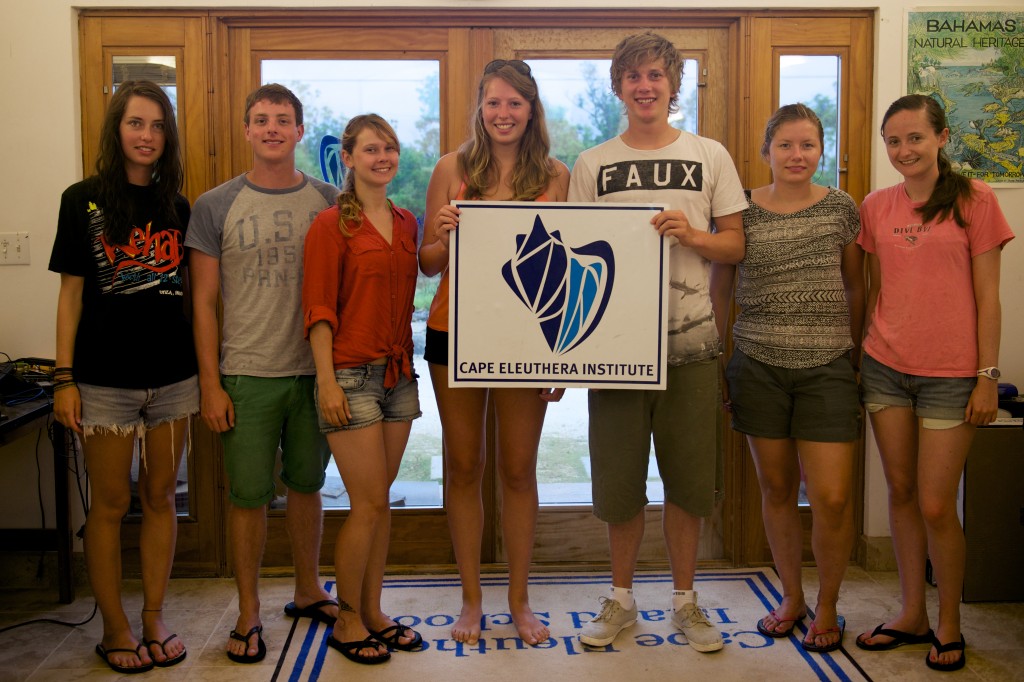All posts by ceiblogger
CEI represented at the American Elasmobranch Society Conference
The 2013 Joint Meeting of Ichthyologists and Herpetologists was held July 10 -15 in Albuquerque, New Mexico. The American Elasmobranch Society participated by hosting 5 days of shark and ray research presentations, and was attended by CEI Research Manager Annabelle Brooks. Topics covered the latest research on the movements, biology, physiology, reproduction and ecology of a variety of species, in the deep sea to shallow coastal habitats. The impressive list of presenters came from all over the United States and Europe, including many graduate students.
Three presentations focused on studies conducted at the Cape Eleuthera Institute. Dr. Jeff Stein, University of Illinois, presented the results of the shark population surveys conducted at ‘the bridge’ over the last 2 years, which show an increase in the abundance of Caribbean reef sharks in the area over the last 30 years. Dr. John Mandelman, New England Aquarium, presented the ongoing study investigating the impact of longline capture on the physiology of sharks, and Ian Hamilton, Memorial University, presented the data he collected during his Masters project conducted last year at CEI. Finally, two past Shark Research and Conservation Program interns attended to present their Masters research projects – congratulations Alexandra Pickard and Jimmy Kilfoil.
Seatrek Fathoms sail into CEI for a 10 day trip
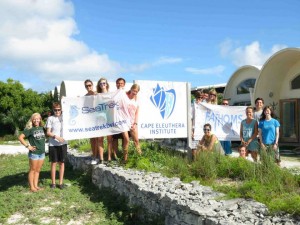 This week we said ‘bon voyage’ to an amazing group of students, staff and crew from Seatrek Fathoms. They graced us with their presence for 10 days of science, fun, research, snorkeling, and much much more.
This week we said ‘bon voyage’ to an amazing group of students, staff and crew from Seatrek Fathoms. They graced us with their presence for 10 days of science, fun, research, snorkeling, and much much more.
A new experience for the education team with the group staying aboard their 65ft sailing schooner named the Avalon. Each day the group made it to land and delved into our program. The focus of this trip was for the students to really get an idea of how a remote field station functions, all the differing aspects of research at CEI and the reality of setting reachable research goals.
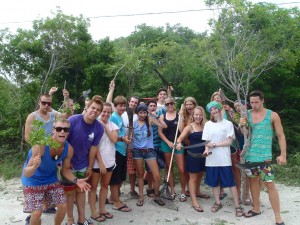
We began our trip with a day sharking out with Owen and his team. It was quite the day long-lining with both the Dave & Di and the Avalon, giving all the students an opportunity to be first hand part on the long-lining crew, switching out with the observers stationed on the Avalon. The day was successful, hooking one Reef Shark, all the students were able to see how shark research works out in the field, and it was a great day had by all. Continue reading
Newcastle University from the UK sends undergraduates to collect data at CEI
Seven undergraduate students from Newcastle University have been on campus since July 1, assimilating with various research groups at CEI. Each student is working on an individual project for their undergraduate thesis. Click below for a summary of the projects:
South Eleuthera Explorers Camp at CEI
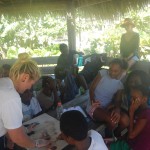
Last week the Cape Eleuthera Institute and the Island School welcomed 18 South Eleutheran children to campus for a sleep away camp focusing on the world we live in and how we can preserve it. Through the camp the kids, who range in age from 9 to 13, are getting to snorkel, dissect fish, participate in research in the fields of conch and bonefish, and travel to the Ocean hole and Rock Sound caves. All of this is coupled with lessons and education on the nature that these children encounter in their daily lives on the island.
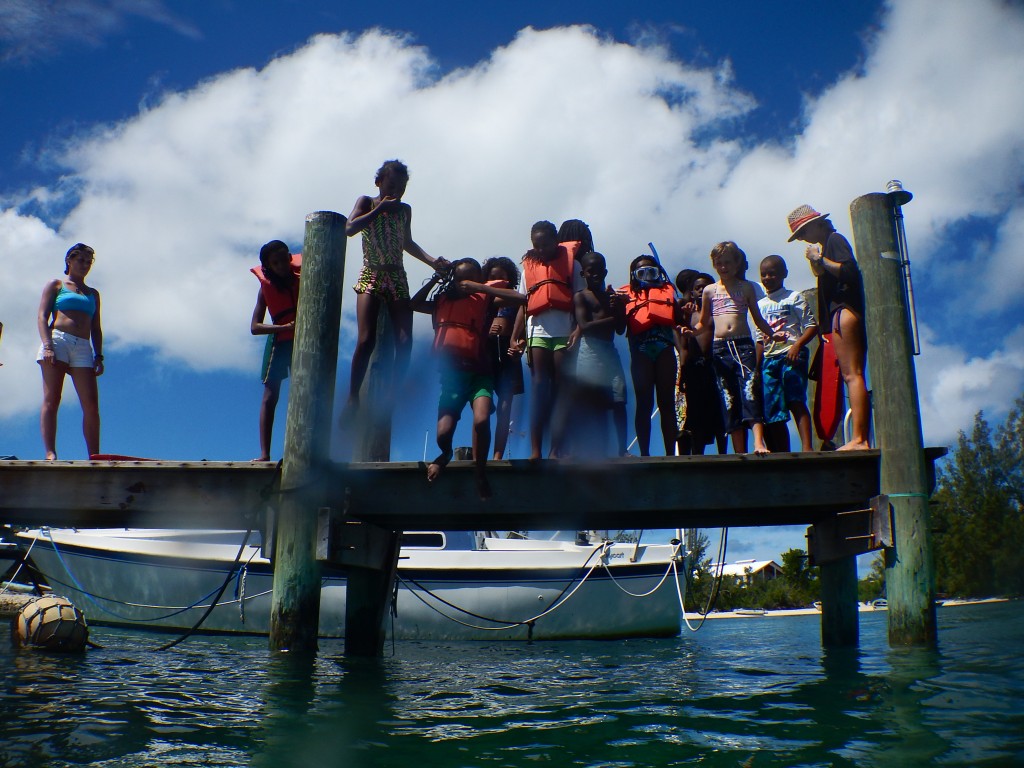
It is the hope of the camp that the kids will take back some lessons in water preservation, harmful effects of lionfish on native ecosystems and living a more sustainable life, and further their education on these topics in the future. Continue reading
Lionfish team completes July patch reef surveys
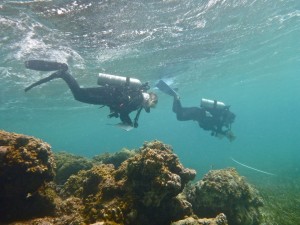
The lionfish team has recently finished their fish abundance surveys, which are undertaken every three months. They visited sixteen reef patches in the Exuma Sound over three days. There are generally two or three recorders (who need to have top notch fish identification skills!). Two team members jump in onto the patch and do roving surveys and record all the fish they can see. Since the patches are part of a lionfish removal versus non-removal comparison study, they also record the number and size of both lionfish and competitors for lionfish, such as groupers.
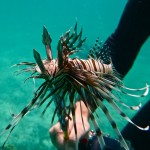
Next, they lay three random transects over the reef and record the species and size of all the fish within one meter of the transect tape. The third recorder lays two transects on the sand on either side of the reef – there’s much fewer fish out there! Finally, if the site is a lionfish removal site, they spear all the lionfish on the patch and take them back to the lab for dissection.
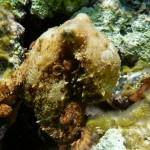
The team was out on the boat the couple of days before tropical storm Chantal was supposed to hit Eleuthera and the weather was crazy! It could change from bright sunshine to lashing rain and waves crashing over the bow in minutes. Despite those moments, the team had a fun time and saw some pretty cool stuff; there was an octopus on one transect, as well as a Dwarf seahorse and a pipefish near different patches. Continue reading
New staff bio for Dr. Owen R. O’Shea
Here is a brief background on our new Shark Research Associate, Dr. Owen R. O’Shea:
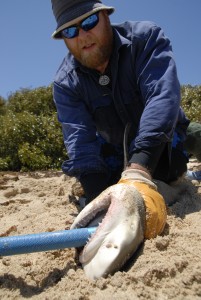 I am a marine ecologist with a background in coral reef ecology and elasmobranch biology. I completed my PhD with Murdoch University and The Australian Institute of Marine Science (AIMS) in 2012 where I worked on tropical dasyatids from Ningaloo Reef, Western Australia. My research so far has highlighted critical ecological functions of sharks and rays within tropical marine ecosystems, including tidal periodicity of manta rays and sharks to oceanic cleaning stations, biophysical processes at inshore reefs by stingrays as well as assessing the spatial ecology of coral reef associated elasmobranch species. My research ambitions align well with the Shark Research and Conservation Program at CEI and I am looking forward to helping out with existing projects as well as developing further research programs, relevant for elasmobranchs in this region.
I am a marine ecologist with a background in coral reef ecology and elasmobranch biology. I completed my PhD with Murdoch University and The Australian Institute of Marine Science (AIMS) in 2012 where I worked on tropical dasyatids from Ningaloo Reef, Western Australia. My research so far has highlighted critical ecological functions of sharks and rays within tropical marine ecosystems, including tidal periodicity of manta rays and sharks to oceanic cleaning stations, biophysical processes at inshore reefs by stingrays as well as assessing the spatial ecology of coral reef associated elasmobranch species. My research ambitions align well with the Shark Research and Conservation Program at CEI and I am looking forward to helping out with existing projects as well as developing further research programs, relevant for elasmobranchs in this region.
BREEF Seacamp at CEI
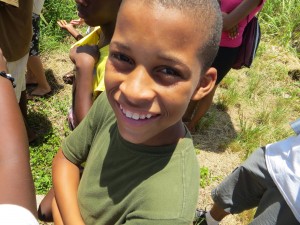 After leading the Deep Creek Natural History Camp, two of our Educational Programs staff helped out with the Bahamas Reef Environment Educational Foundation (BREEF) week-long SeaCamp. They met up with the campers in Governor’s Harbour (GH) for a field trip. When they got to the Haynes Library, the BREEF camp leader (and IS/CEI alum) – Allanah – had all the kids excited and ready for their first field trip.
After leading the Deep Creek Natural History Camp, two of our Educational Programs staff helped out with the Bahamas Reef Environment Educational Foundation (BREEF) week-long SeaCamp. They met up with the campers in Governor’s Harbour (GH) for a field trip. When they got to the Haynes Library, the BREEF camp leader (and IS/CEI alum) – Allanah – had all the kids excited and ready for their first field trip.
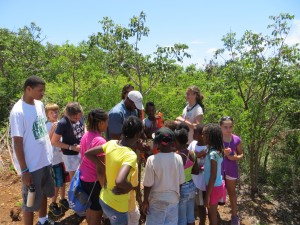 The first stop was the Hatchet Bay Caves and then they toured a brand new, organic farm just across from the caves. The kids learned all about the farm including the mango trees that will fruit twice a year and the miracle fruit that makes anything you eat, after eating this fruit, taste like the sweetest thing. It felt like a field trip to Willy Wonka’s chocolate factory! Next they went to Cheetah’s pineapple farm and learned about the lost art of farming pineapple in the red soils of Eleuthera. Several kids went home with ‘pineapple slips’, part of the plant you can pop into some water and 19 months late have a fruit to eat. And that was just the morning!
The first stop was the Hatchet Bay Caves and then they toured a brand new, organic farm just across from the caves. The kids learned all about the farm including the mango trees that will fruit twice a year and the miracle fruit that makes anything you eat, after eating this fruit, taste like the sweetest thing. It felt like a field trip to Willy Wonka’s chocolate factory! Next they went to Cheetah’s pineapple farm and learned about the lost art of farming pineapple in the red soils of Eleuthera. Several kids went home with ‘pineapple slips’, part of the plant you can pop into some water and 19 months late have a fruit to eat. And that was just the morning!
Continue reading
CEI’s Flats Program releases The Bahamas’ second largest bonefish tagged to date
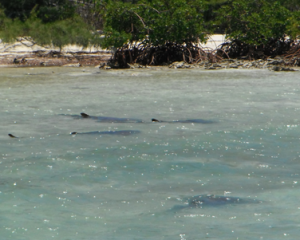
This June, The Flats Ecology Program (FECP) continued its bonefish tagging efforts as part of The Bahamas Initiative, an ongoing project between CEI, the Fisheries Conservation Foundation, and the Bonefish and Tarpon Trust, to assess population size, movements, and growth of The Bahamas’ bonefish population. The latest tagging efforts on Grand Bahama Island, funded in part by The Moore Foundation, brought a close to the six week research expedition across The Bahamas by CEI and Stony Brook University researchers (see “Shark Expedition” updates below).
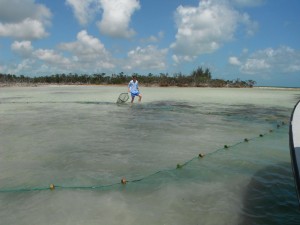
CEI researcher Zach Zuckerman and FECP collaborator Justin Lewis first targeted bonefish near Lucayan National Park along the southern shore of Grand Bahama. Due to high winds and pounding surf, the researchers trailered their boat to the southeastern tip of the Island, near Deep Water Cay, and almost immediately spotted schools of fish. To capture bonefish, the researchers quickly and stealthily unravel a 150 ft. net a distance in front of the school, then rush to encircle the fish. The fish are allowed a few minutes to settle down before individuals are hand netted from the school, length measurements recorded, sex determined based on the presence of milt (sperm) or eggs, and an external tag embedded in the dorsal muscle of the fish. The tag has both a unique number and contact information printed on it so that fishermen and guides can report when and where fish are recaptured, thus providing The Bahamas Initiative tagging program with invaluable data on growth and movement.
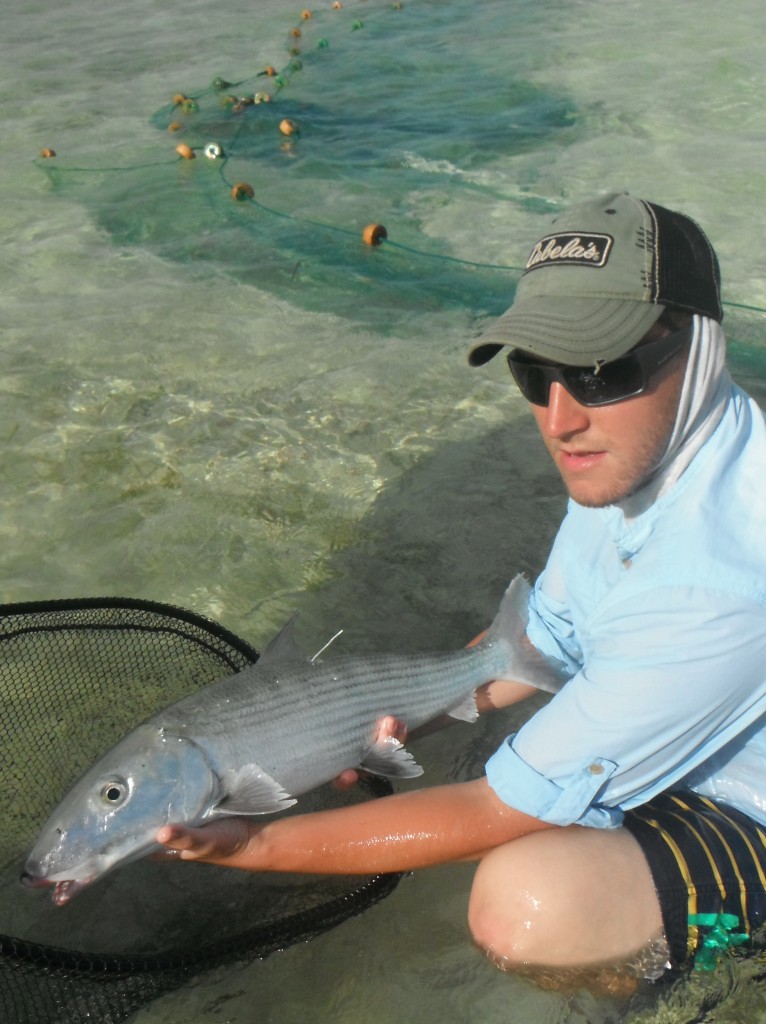
A total of 102 fish were captured, three of which had been previously tagged. Included in the 99 newly tagged individuals was a whopping 67.2 cm (26.5 in) fish estimated at 11 pounds – the second largest bonefish tagged to date in The Bahamas! In addition to bonefish, several juvenile and adult lemon sharks and bonnethead sharks were also tagged along the northern shore of the island with the assistance of guides from H2O Bonefishing, Freeport. Continue reading
Stress and the Incredible Checkered Puffer
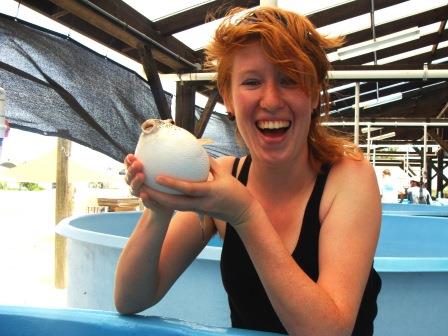
How do fish handle stress? With the rise of human and climate related stressors, researchers are actively exploring how fish react to these conditions. Naomi Pleizier, a MSc. student from the Cooke Lab at Carleton University, Ottawa, Canada, ventured to CEI to discover how short-term stress affects the long-term fitness of one of the mangrove ecosystem’s most charming residents, the checkered puffer fish (Sphoeroides testudineus).
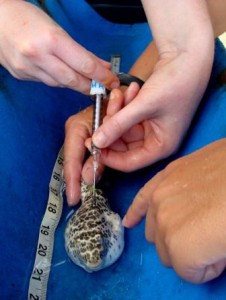
Adapted to the dynamic mangrove habitat, checkered puffers are well equipped to handle the fluctuating environment and the threat of predators. This species has an amazing tolerance of a range of salinities and temperatures. Predators must beware of these harmless looking little fish; not only do they puff to an incredible size in response to threats; they are also rendered toxic by the plankton living in their tissues. Not only that, but they have a mean bite, as study volunteers can attest to!
The puffers’ active responses to predators make them an excellent candidate for the study of stress. The research team collected puffers from Paige Creek and transported them to the CEI lab for treatment. Continue reading
